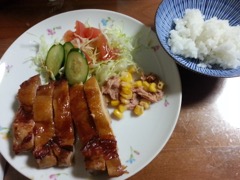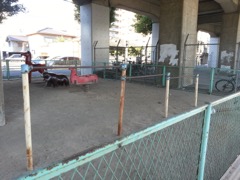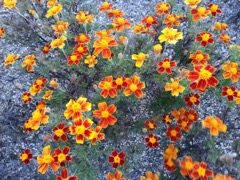
If toys could talk this one might have some tales to tell. I didn't know Canada exported much to Japan.

Emily as a bag lady.

Alas, despite the implied promise made by the shirt, Emily was *not* handing out hot biscuits today.

I've had trouble researching where the basic concept of a "dozen" comes from, but i suspect it is part of Western culture and not a universal thing. As evidence of this, i offer that things in Japan are usually counted by tens, such as these eggs. I can't remember the last time i saw something sold in groupings of 12 in Japan.

Another typical supper: salad, tuna corn, chicken, rice.


Rice, a few hours before harvest. Plots of land in the city that do not have a building or a park usually have either rice or fruit trees. Took this photo when Yuri and i were out for a long walk. We saw people harvesting rice in other paddies.

We stopped for matcha soft cream. This is from the 3rd-best source in Fukuyama, located in the Youme Town mall. 2nd-best is at a shop in Tenmaya Happy Town, which is a higher-end mall. And the very best is at a rather nice tea shop in the expensive district near the central train station.

Stopped in a park to rest for a bit. Yuri had a melon Calpico. For those who can read some Japanese, yes i realize that "Calpico" is not what the container says. But Calpico is what the company uses in English-speaking countries, where the real name sounds too close to "cow piss" to sell very well.

There's a little park under the shinkansen tracks.

...A rather lonely little park.

A rare glimpse of solitude in Japan.

The park under the tracks just felt very lonely and almost depressing to me. It was a rather eerie feeling, very unusual for Japan to find such a dead space.

Another lonely space under a different part of the tracks. Looks like little shops, but they've been abandoned for awhile. Still, despite this space being disused, note how clean it is. Even the empty spaces in Japan get cleaned regularly. Who pays for people to clean, i don't know.

I did not expect to find reserved parking for my narwhal in Japan.

We walked all the way to the central train station (and then rode the train back home--2 stations away). There's a rose garden in front of it; the rose is the symbol of Fukuyama, so they are rather common in public spaces.

Sculpture in front of the station.

「ばらのまち福山」means "Rose City Fukuyama". Yuri's covering part of it, but i think the other side says 「ビューティフルふくやま」, or "Beautiful Fukuyama".

Inside the train station. We found a ghost!

This isn't our train, but it is typical of the local trains. Japan has multiple train networks. There are the shinkansen, which are very fast and have separate tracks. Shinkansen do not stop at every city. Then there is a national network of slower trains that are used for both passenger and commercial traffic. Such trains are cheaper than the shinkansen. Finally, there are the local trains, that run either within a city, or just between a small number of cities that only span a couple of prefectures.



This one is ours.

After the train ride we still had a 1 km walk from the station back home. Passed by some flowers.

We also passed by a temple. It is somewhere up the hill.

Yuri insisted i take her picture here.

Wish i had my real camera instead of the cell phone to capture the late-afternoon sun.


Sometimes the drainage ditches next to the road are scary deep. There's no railing, no wall, nothing. It is just assumed in Japan that people are smart enough to not fall in.

More flowers on the way home.